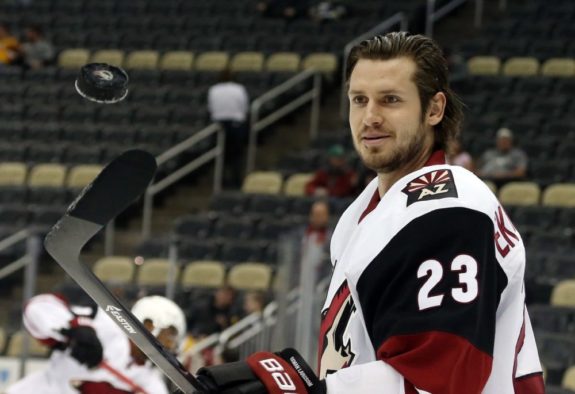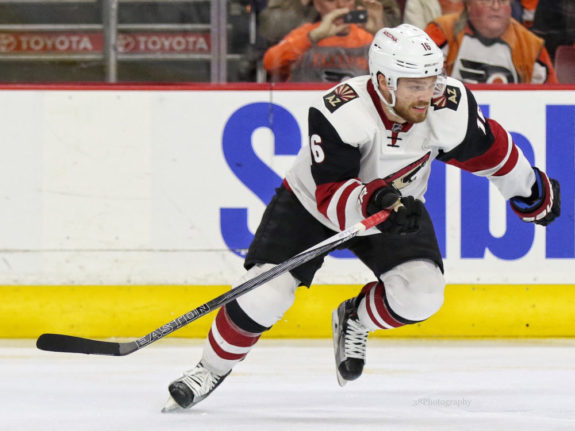Perhaps there is a recognition on the part of Arizona Coyotes head coach Dave Tippett that what he sees is likely the end product.
At the start of the current NHL season, the expectation for the Coyotes was heightened. Here’s a team just one season away from one of the most disastrous campaigns in franchise history. Speculation abounded about Tippett’s desire to stay in the desert and his ability to cope with mounting losses.
Then, the draft of 2015 and a few trades. Notably, the Coyotes selected Max Domi as the 12th overall pick in the draft, dealt for the speedy Anthony Duclair, developed patience for defensemen Connor Murphy and Michael Stone to develop and witnessed the emergence of goalie Louis Domingue as both a capable backup to Mike Smith as well as a legitimate starter.
Add the emergence of Oliver Ekman-Larsson as an elite defenseman and the continued leadership from captain Shane Doan and Tippett had enough reasons to remain.

In the spring of 2016, the franchise added John Chayka as general manager and his broad-based application of analytics enhanced Tippett’s teaching methods on the ice. The result was an enthusiasm not felt nor believed for several years.
Room for Optimism
Now, the front office seemed secure. After years of ownership by the NHL and protracted battles with the city of Glendale, the Coyotes were in private ownership. Majority owner Andrew Barroway and team CEO Anthony LeBlanc said they were committed to keep the Coyotes in Arizona and then partnered with Arizona State University to build a new arena on the edge of the Sun Devils’ campus.
All of this promise came to a thundering halt. That’s because the Coyotes, for all of the positives, did not execute on the ice. Currently in their mandatory break dictated by the NHL, the team has one of the worst records in the NHL. The once bright hope of contending for a spot in the Stanley Cup playoffs has faded like a brilliant sunset in the Arizona desert.
“Frustrated,” was the way Tippett described the current state of affairs to The Hockey Writers. “There is a strong determination, effort and a lot of try. They just need to find a way to get it done.”
The bottom of the 2016-17 season fell out early.
After defeating the Philadelphia Flyers in overtime on opening night, the Coyotes proceeded to drop their next five games in a row and allowed a total of 23 goals in those contests. By the first week in January, they picked up standing points in back-to-back games only three times. Their longest winning streak was that of two games and achieved only twice.
All of which makes for a difficult experience, but one which does not include lack of effort. As long as Doan wears the captain’s “C,” the resolve will be ever-present.
“The younger guys have to constantly play at a top level,” Doan said. “At this point, we need to find ways to win and more frequently.”
If the Coyotes were excited by adding players like Domi, Duclair, defenseman Jakob Chychrun and Tobias Rieder to emerge as an offensive threat and one of the top penalty killers in the league, production from these players is not on the same level as expectation.
Production Down
By their five-day break, mandated by the NHL from Jan. 8 to the 12, several players were underachieving. Duclair, who scored 20 goals last season and added 24 assists, scored just three times in his first 37 games of the season. Domi scored five goals in his first 26 games and broke his hand in a fight against Calgary on Dec. 8. Though now skating, Domi could still be several weeks away from returning to the lineup.

By the mandatory break, no player scored goals in double figures and only Radim Vbrata, with nine, was the closest.
All of which plays heavily on Tippett.
“You hope that your team recognizes how hard it is to win in this league,” he said. “There were stretches which we played well. In some games, we just didn’t get the save at the right time or we didn’t compete for the whole 60 minutes.”
With the second half of the season ahead, Tippett hopes enough time remains to show encouraging signs for the future.